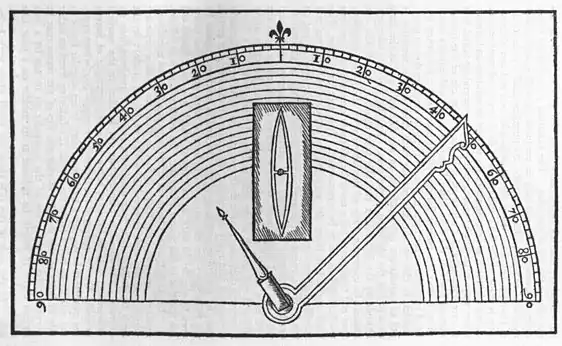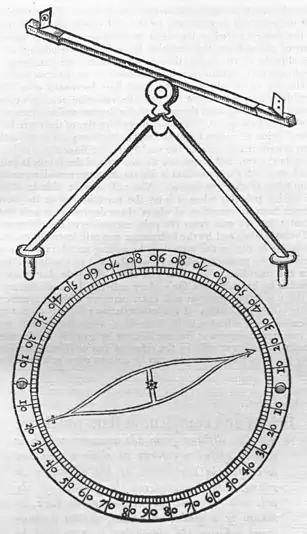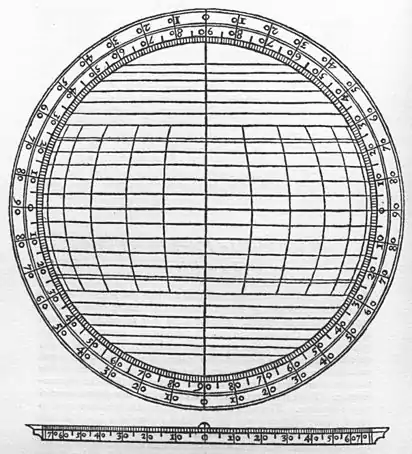CHAP. XII.
On the finding of the amount of variation: how great
is the arc of the Horizon from its arctick or antarctick
intersection of the meridian, to the point
respective of the magnetick needle.



Bright and conspicuous stars[230] which are
not far distant from the equator which it
will be useful to observe at their rising and
setting: the amplitude at the Horizon on
rising being known from the altitude of the
pole and from the declination of the stars, by
means of a globe, or tables, or an instrument
whence the variation is perceived by
technical calculation.
| Right Ascension | Declination | |
| Oculus Tauri | 62° 55' | 15° 53' N |
| Sinister humerus Orionis | 72° 24' | 4° 5' N |
| Dexter humerus Orionis | 83° 30' | 6° 19' N |
| Præcedens in cingulo Orionis | 77° 46' | 1° 16' S |
| Canis major | 97° 10' | 15° 55' S |
| Canis minor | 109° 41' | 5° 55' N |
| Lucida Hydræ | 137° 10' | 5° 3' S |
| Caput Geminorum australe | 110° 21' | 28° 30' N |
| Caput boreale | 107° 4' | 32° 10' N |
| Cor Leonis | 146° 8' | 13° 47' N |
| Cauda Leonis | 171° 38' | 16° 30' N |
| Spica Virginis | 195° 44' | 8° 34' S |
| Arcturus | 29° 13' | 21° 54' N |
| Cor Aquilæ | 291° 56' | 7° 35' N |
An instrument for finding the amplitude at rising on the horizon.
Describe the circumference of a circle and let it be divided into quadrants by two diameters intersecting each other at right angles at its centre. One of these will represent the æquinoctial circle, the other the axis of the world. Let each of these quadrants be divided (in the accustomed way) into 90 degrees; on every fifth or tenth of which at each end of each diameter and on each side let marks (showing the numbers) be inscribed on the two limbs or margins made for that purpose outside the circumference. Then from each degree straight lines are drawn parallel to the æquator. You will then prepare a rule or alhidade equal to the diameter of that circle and divided throughout into the same parts into which the diameter of the circle representing the axis of the world is divided. Let there be left a small appendage attached to the middle of the rule, by which the middle of the fiducial line itself of the rule may be connected with the centre of the circle: but to every fifth or tenth part of that rule let numbers be attached proceeding from the centre toward each side. This circle represents the plane of the meridian; its centre the actual point of east or west, i.e., the common intersection of the horizon and æquator; all those lines æquidistant from the æquator denote the parallels of the sun and stars; the fiducial line of the rule or alhidade represents the horizon; and its parts signify the degrees of the horizon, beginning from the point of setting or of rising.

Therefore if the fiducial line of the rule be applied to the given latitude of the place reckoned from either end of that diameter which represents the axis of the world; and if further the given declination of the sun or of some star from the æquator (less than the complement of the latitude of the place) be found on the limb of the instrument; then the intersection of the parallel drawn from that point of the declination with the horizon, or with the fiducial line of the rule or alhidade, will indicate for the given latitude of the place the amplitude at rising of the given star or the sun.
The page and line references given in these notes are in all cases first to the Latin edition of 1600, and secondly to the English edition of 1900.
Page 172, line 13. perquirere. The edition of 1633 reads perquirero, in error.
228 ^ Page 172, line 29. Page 172, line 33. Ad pyxidis nauticæ veræ & meridionalis formam ... fiat instrumentum.—An excellent form of portable meridian compass, provided with sights for taking astronomical observations, is described by Barlowe (The Navigators Supply, London, 1597), and is depicted in an etched engraving. An identical engraving is repeated in Dudley's Arcano del Mare (Firenze, 1646). Gilbert's new instrument was considerably larger.
229 ^ Page 174, line 19. Page 174, line 21. addendo vel detrahendo prostaphæresin.—"Prosthaphæresis, conflata dictione, ex additione et subtractione speciebus logistices, nomen habet ab officio, quia vt in semicirculo altero ad æquabilem motum adijcitur, ita in altero subtrahitur, vt adparens motus ex æquabili taxetur: atque hinc fit, quòd quæ Prosthaphæresis dicitur Ptolemæo, ea vulgò æquatio vocetur." (Stadius, Tabulæ Bergenses, Colon. Agripp., 1560, p. 37.)
230 ^ Page 174, line 28. Page 174, line 31. Stellæ Lucidæ.—According to Dr. Marke Ridley (Magneticall Animadversions, London, 1617, p. 9), this chapter xii. of book iv., with the Table of Stars, was written by Edward Wright, the author of the Prefatory Epistle of De Magnete. Wright was Lecturer on Navigation to the East India Company, and author of sundry treatises on Navigation.